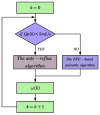Pulsatile Physiological Control of Blood Pump-Cardiovascular System Based on Feedforward Compensation
- PMID: 40572384
- PMCID: PMC12195064
- DOI: 10.3390/mi16060664
Pulsatile Physiological Control of Blood Pump-Cardiovascular System Based on Feedforward Compensation
Abstract
Rotary Blood Pump (RBP) is a commonly used ventricular assist device. However, the constant speed operation of the blood pump leads to a reduction of blood flow pulsatility, which triggers a series of adverse reactions. In this paper, a pulsatile physiological control with feed-forward compensation (FFC) is designed to regulate the rotational speed in real time to accurately output pulsatile blood flow to address this problem. The coupled model of the Rotary Blood Pump and cardiovascular system (CVS) is established in the SIMULINK software as the research object. The designed pulsatile physiological control algorithm contains the feed-forward compensation-based pulsatile control and anti-reflux algorithm, switching the applicable algorithm based on the pump flow. When the flow rate is higher than the threshold, feed-forward compensation is introduced and combined with PI feedback control to improve the performance of pulsation tracking; when the flow rate is lower than the threshold, it is switched to the anti-reflux algorithm to gradually increase the pump speed. Simulation shows that the designed feed-forward compensation link reduces the tracking error of the pulsatile physiological control by 80%. In the case of a 50% sudden change of physiological parameters, it can track quickly and stably and avoid reflux. The pulsatile performance and ventricular unloading performance are better compared with no feed-forward compensation pulsation control as well as constant-speed control. An increase of 30 mmHg in aortic beat-to-beat differential pressure was achieved in the extracorporeal circulation experiments, which is important for the realization of pulsatile flow control of the Rotary Blood Pump.
Keywords: Rotary Blood Pump; cardiovascular system; feed-forward compensation; physiological; pulsatility.
Conflict of interest statement
The authors declare no conflicts of interest.
Figures
















Similar articles
-
Intravenous magnesium sulphate and sotalol for prevention of atrial fibrillation after coronary artery bypass surgery: a systematic review and economic evaluation.Health Technol Assess. 2008 Jun;12(28):iii-iv, ix-95. doi: 10.3310/hta12280. Health Technol Assess. 2008. PMID: 18547499
-
Immunogenicity and seroefficacy of pneumococcal conjugate vaccines: a systematic review and network meta-analysis.Health Technol Assess. 2024 Jul;28(34):1-109. doi: 10.3310/YWHA3079. Health Technol Assess. 2024. PMID: 39046101 Free PMC article.
-
Home treatment for mental health problems: a systematic review.Health Technol Assess. 2001;5(15):1-139. doi: 10.3310/hta5150. Health Technol Assess. 2001. PMID: 11532236
-
Surveillance of Barrett's oesophagus: exploring the uncertainty through systematic review, expert workshop and economic modelling.Health Technol Assess. 2006 Mar;10(8):1-142, iii-iv. doi: 10.3310/hta10080. Health Technol Assess. 2006. PMID: 16545207
-
Automated monitoring compared to standard care for the early detection of sepsis in critically ill patients.Cochrane Database Syst Rev. 2018 Jun 25;6(6):CD012404. doi: 10.1002/14651858.CD012404.pub2. Cochrane Database Syst Rev. 2018. PMID: 29938790 Free PMC article.
References
Grants and funding
LinkOut - more resources
Full Text Sources
Research Materials
Miscellaneous

